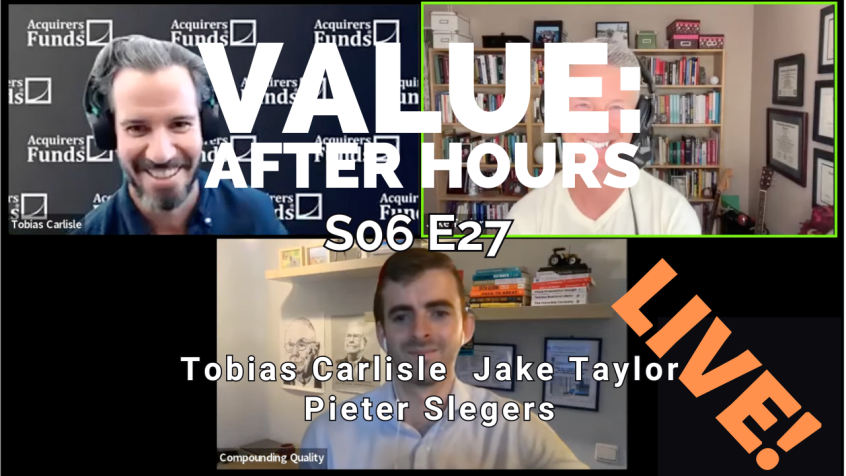During their recent episode, Taylor, Carlisle, and Pieter Slegers discussed How to Use Reverse DCF and EPS Growth Models in Quality Investing, here’s an excerpt from the episode:
Jake: Let’s talk about the valuation component, because this is I think where it might get difficult for some with trying to imagine– [clears throat] I feel like that there’s been a reasonable shift in the industry, I think, towards quality and recognizing it and people generally paying up for quality. And is there some price where eventually you say, “Gosh, I just don’t know how I can win from here, even if this is the best company in the world.”
Pieter: Yeah, sure. So, as I mentioned briefly in the beginning, I used to work in the industry for three years actually. And then, obviously, you are working as analyst, you are building those Excel models with 500 rows, 1,000 assumptions and so on and so on. I really believe in the idea to keep it simple. So, I think rule of thumb should be really good.
For me, personally, I always use three models or three ways to look at valuation. First is very naive in some way and very simplistic. It’s just comparing the forward PE of the company with the historical average from the past 10 years. Obviously, that doesn’t say a lot because it also depends on the outlook of the company, what’s happening, the balance sheet and so on and so on. But it gives a first indication.
Second and third model are more interesting. Probably, it’s an earnings growth model and then a reverse DCF. Well, earnings growth model, in theory, it’s really easy which return you will get as an investor in the sense that it’s always your EPS growth of the future, plus the dividend yields, plus or minus the change in the valuation. So, obviously, the EPS growth is an assumption, the change in the valuation is an assumption.
But you try to, for example, use an exit PE, exit price earnings ratio, which you think is fair in the very long-term and rather low to use a margin of safety, then you try to make an educated guess about EPS growth, you can do that via management guidance, expectations of analysts, but obviously those are most of the time way too optimistic. So, also there you can use a margin of safety.
But for me, personally, when I do research for a quality stock, I want the outputs in earnings growth model to be at least 10%, so that your expected return per year is at least 10%. You can even put it a bit higher, for example, 15%, meaning that the stock will double in five years or more or less, and then you have an extra margin of safety.
And then the third model is the reverse DCF, like Munger said, “Invert, always invert. Turn the problem upside down.” So, with the reverse DCF, you are not making many assumptions yourself, but you just try to or you look at which expectations are implied in the current stock price. And yeah, obviously, you want those expectations implied in the stock price to be more or less correct.
When you take a company like LVMH, for example, which obviously maybe a disclaimer. Nothing I mentioned here is investment advice. But for example, for LVMH, well, the implied free cash flow growth for the next 10 years in reverse DCF is something like 10% or 11%. Is it realistic? Well, I think it might be the case. Well, everyone should do its own due diligence, probably, but 10% or 11% is more or less how LVMH has grown in the past.
Well, another extreme. Take Nvidia, for example, a company everyone is talking about, writing something about it on Thursday. That’s why I know the numbers by-heart. When you do a reverse DCF on Nvidia, it states that their free cash flow should grow by 27% over the next 10 years. But when you do that, it also means that in 10 years from now, Nvidia should generate more cash than all big tech stocks combined today, so Facebook, Amazon, Apple, Netflix, Microsoft, Alphabet, and so on. Is it realistic? I don’t think so. Could it happen? Yes, but there is probably no margin of safety at all. So, that’s how I try to think about valuation.
I think also that you hit a very good point in the sense that quality investing is becoming more and more popular. And over the past years, even over the past decades, quality investing has done really well. Declining interest rates have definitely helped quality investing in the past. So, the comparison or will it outperform as much over the next two decades as it did over the past two decades? Well, probably not is the honest answer, but still believing there in the strategy.
Because for a value investor, for example, the margin of safety is in the low valuation level. For a quality investor, the margin of safety is more in the moat of the company. And the longer your investment horizon, the longer you keep a company, the less important valuation becomes and the more the growth of the intrinsic value becomes. Obviously, this doesn’t mean that you don’t need to take into account valuation at all, because then some horrible things can happen. But it’s more like trying to buy those companies at a fair valuation multiple and not trying to buy them dirt cheap, for example.
You can find out more about the VALUE: After Hours Podcast here – VALUE: After Hours Podcast. You can also listen to the podcast on your favorite podcast platforms here:
For all the latest news and podcasts, join our free newsletter here.
Don’t forget to check out our FREE Large Cap 1000 – Stock Screener, here at The Acquirer’s Multiple:



